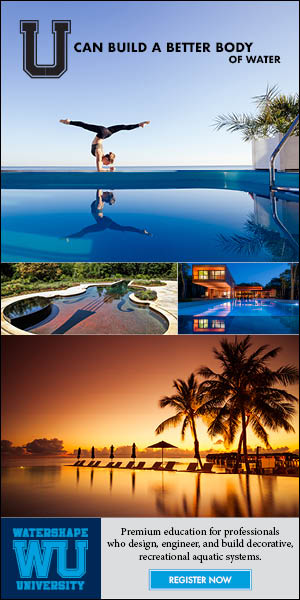WaterShapes
Swimming pools and other watershapes make great subjects for photographers, which makes it logical that every year or two I've be able to amass a new collection of these books to review. In general, publications such as these are all about pretty projects and are aimed mainly at consumers, but I've always found them useful as sources for design ideas and, in general, as a means of seeing what other people are doing. For the most part, however, these publications are not particularly "informative": Once you get past the pictures, there's really not much else there to build knowledge or advance the craft. Such is the case with all four of the publications I'll cover here in quick, round-up fashion. All are beautifully illustrated, and some display an interesting range when it comes to
Beginning a project can be wonderfully exciting, especially when you're working in a beautiful place with a terrific client who wants something truly elegant and special. In fact, I can honestly say that there's nothing quite like the exhilaration of stepping into a new situation with great potential, defining those possibilities and watching a client's eyes light up with the fire of inspiration. Case in point: Not long ago, my partner Kevin Fleming and I were called out to a job site on Long Beach Island, N.J., by local landscaper Mark Reynolds, who'd heard of us and our reputation for using top-quality materials in top-flight designs. When we pulled up, the first thing I noticed was the
When you ask people about transparent building materials, most people immediately think of glass. Glass is certainly stronger than most people realize, but it has never been an ideal structural material because of its weight, brittleness and structural limitations. With our acrylic products, by contrast, architects and other designers have found a material with which they can create substantial transparent structures that are much lighter and more versatile than those made with glass – and with a structural strength more than double that of concrete. R-Cast acrylic (as we call it) is indeed an amazing material: Its uses span from the obvious pools, fountains or aquariums to awesome signage and seemingly impossible structures and lighting (to mention a few possibilities). Its combination of optical clarity with safety, strength, flexibility and UV resistance has allowed an increasing numbers of designers across a range of disciplines to embrace the material as never before. There are several firms that provide acrylic materials to the construction marketplace, with
Practice makes perfect when it comes to developing the observational skills you need to support your design acumen. As I discussed last month, honing these abilities enables a designer to see individual and collective shapes within a garden setting in ways that can enhance the overall appearance of plant/hardscape combinations and turn them into cohesive and more compelling visual compositions. Among all of those artistic abilities is one specific skill that has served me best and will be my subject in this column: That is, the ability to determine the level of contrast my clients want to see in their garden spaces. As an artist, I've always been inspired by the areas in paintings that display the
Despite the axiom that "every client is a good client," we all know that some of them are wonderful to work with - and that dealing with others is a form of slow torture. I've always loved hearing the horror stories about bad customers that float around the watershaping trades: The telling and retelling of these nightmares (often with exaggerations as the stories travel from ear to ear) is often a treat, and I know I've had my share of therapeutic fun at the expense of a knucklehead or two. We don't generally hear quite so much about the good ones, but it's fair to say that most of us have lists of satisfied clients and that our experiences with them give us much of the motivation we have to stay in the business. What it boils down to is this: Each and every client is
If you're like me, news stories in magazines and on television that cover innovations in science and technology are far more interesting than about 95 percent of the stuff featured in the mainstream media these days. To me, few things are more intriguing than peeking in on the
For the typical visitor, the newly-reopened Getty Villa is perhaps the most exquisite of all possible venues for viewing ancient works of art and craft - reason enough to plan a visit. For students of architecture and design, however, there's much more, particularly the opportunity to immerse yourself in the living, breathing environment of a classic Roman villa and its abundant amenities. The Getty Villa site encompasses 64 acres of a rugged canyon rising above the Pacific Ocean in Malibu, Calif., and was once home to oil tycoon J. Paul Getty. A fanatical collector of Greco-Roman antiquities, he dedicated part of his original ranch-style home as a public museum in 1954. By 1974, less than a year before his death, he had completed and opened the original Villa on another part of the estate, realizing his ambition of creating a public monument dedicated to the arts. The Villa's layout was inspired by the Villa dei Papiri, a first-century country house in Pompeii buried by the eruption of Mt. Vesuvius in 79 A.D. It was Getty's vision to display his collection in a setting evocative of its contents' historic origins and he realized it, but there were compromises: The spaces were crowded, and the works on display also included samples of paintings and craftworks of much more recent vintage - Renaissance masters, baroque furnishings and other distinctly non-classical artworks. The Villa closed in 1997 at about the same time the
When we first began collaborating on projects with top-flight architects, landscape architects and landscape designers several years ago, for the most part our role in terms of design was fairly limited: We'd receive requests for bids and proposals based on plans of varying detail, and our role was that of faithful installers of the design. On occasions, of course, we'd also refer our own prospective clients to those same designers, who would generate plans that we would in turn estimate and very often install. We still work that way, but as we've built our ties to these accomplished artists, we've become aware that our role in their projects has been growing, even to the point where we are now being asked in many situations to offer our own design ideas. We're also seeing that, when on-site decisions must be made, these designers are
If you've yet to read any of the works of business guru Tom Peters, you're in for a real treat. A few years ago Peters wrote Re-Imagine, a book that established his reputation as a leader in the field of business philosophy and education. Last year, he released a trilogy of new books that expand on the themes and discussions that have made him both well known and hugely respected. Although published in three separate volumes, this series - Tom Peters Essentials: Leadership, Tom Peters Essentials: Talent and Tom Peters Essentials: Trends (all from DK Publishing, 2005) - is basically a single, remarkably well-written treatise loaded with
Plagiarism. Copyright infringement. Theft of intellectual property. We hear and read about these crimes in the media all the time and don't think they'll ever affect us. But I can bear witness to the fact that we have people in our midst who seem to think that committing these crimes is no big deal. Setting aside any other criticism I've ever lain at the feet of the watershaping trades, if there's one intolerable problem the industry has, it's that there are people within it who are apparently willing to steal to get ahead. I'm not talking about job-site incidents where materials or tools mysteriously vanish. That's a real problem, but even more damaging in my eyes is the surprisingly common practice that some people have of representing the efforts of others as their own. In a phrase, I'm talking about






















